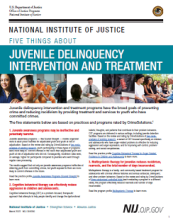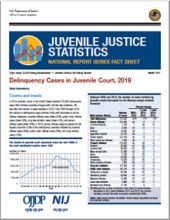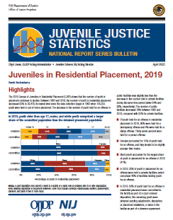Juvenile (under 18)
Defining and Measuring Youth Digital Citizenship
Cross-Validation of the Inventory of Callous-Unemotional Traits Across Reporters and Genders in a Sample of Detained Youth
Evaluation of a Multi-Session Group Designed To Prevent Commercial Sexual Exploitation of Minors: The "My Life My Choice" Curriculum
CrimeSolutions (National Institute of Justice)
Multisystemic Therapy for Juvenile Sexual Offenders: 1-Year Results from a Randomized Effectiveness Trial.
Frontal sinus development and juvenile age estimation
Randomized Trial of Treatment for Children With Sexual Behavior Problems: Ten Year Follow-Up
Do Gender and Exposure to Interparental Violence Moderate the Stability of Teen Dating Violence?: Latent Transition Analysis
NIJ FY22 Research on Juvenile Justice Topics
With this solicitation, NIJ, in collaboration with the Office of Juvenile Justice and Delinquency Prevention, seeks proposals for rigorous research and evaluation projects that inform policy and practice in the field of juvenile justice. Specifically, this solicitation seeks proposals for studies that advance knowledge and understanding in the following three categories: (1) juvenile indigent defense in delinquency proceedings, (2) co-occurring mental health and substance...
NIJ FY22 National Juvenile Justice Data Analysis Program
With this solicitation, NIJ, in collaboration with the Office of Juvenile Justice and Delinquency Prevention (OJJDP), seeks proposals for funding to support and enhance the National Juvenile Justice Data Analysis Program (NJJDAP). The NJJDAP produces vital statistical information to the field regarding juvenile risk behaviors, juvenile victimization, juvenile offending, and the juvenile justice system’s response to law-violating behavior. The successful applicant will work collaboratively with...
NIJ FY22 Research and Evaluation on School Safety
With this solicitation, NIJ seeks proposals for rigorous research and evaluation projects to: 1) study the root causes and consequences of school violence and 2) examine the impact and effectiveness of awards made under the STOP School Violence Act purpose areas.
Risk and Protective Pathways to Peer Victimization from Infancy to Adolescence: Role of Fathers
Desistance From Crime: Implications for Research, Policy, and Practice
Most scholars would agree that desistance from crime – the process of ceasing engagement in criminal activities – is normative. However, there is variability in the literature regarding the definition and measurement of desistance, the signals of desistance, the age at which desistance begins, and the underlying mechanisms that lead to desistance. Even with considerable advances in the theoretical understanding of desistance from crime, there remain critical gaps between research and the application of that research to practice.
Review the YouTube Terms of Service and the Google Privacy Policy








